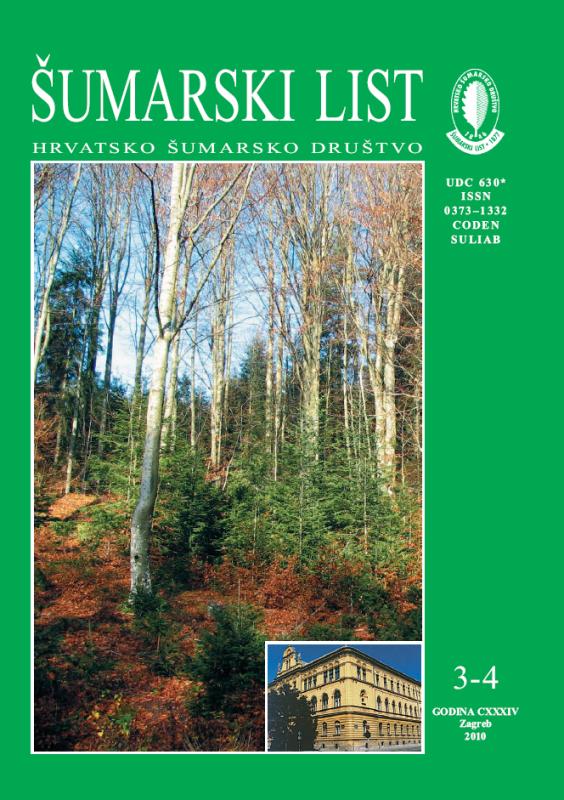
broj: 3-4/2010
pdf (7,3 MB) |
|
||||||||||||||
| RIJEČ GLAVNOGA UREDNIKA | ||
| Branimir Prpić | ||
| FOREST DAY, WORLD WATER DAYANDWORLD METEOROLOGICAL DAY pdf HR EN | 101 | |
| IZVORNI ZNANSTVENI ČLANCI | ||
| Zečić,Ž., D. Vusić, M. Prka, S. Klepac | UDK 630* 377 (001) | |
| Influence of Skidding Road Slope on Productivity of Skidding Timber Assortments with Tractor Timberjack 240C in Selective Forests pdf HR EN | 103 | |
| Ostrogović, M.Z., K. Sever, I.Anić | UDK 630* 231 (001) | |
| Influence of Light on Natural Regeneration of Pedunculate Oak (Quercus roburL.) in the Maksimir Forest Park in Zagreb pdf HR EN | 115 | |
| Summary: In a forest park Maksimir, in a mixed forest stand of Pedunculate Oak and Common Hornbeam (Carpino betuli-Quercetum roboris/Anić 1959/ Rauš 1969), influence of light conditions on number and quality of young oak growth was investigated. Experimental plot covered two regeneration gaps and the space between, including the trees in a different stage of development (seedlings, saplings and young trees). Measurements were taken in the winter 2006 and spring 2007 in a single plot within the stand. The plot was divided in 105 sub-plots of 1.5 m x 1.5 m and on each sub-plot height (cm), tree length (cm), ground level diameter (mm) and last five height increments (cm) were measured. Parallel to the measurement, evaluation of stem quality, crown form and tree health state was conducted. Spatial distribution of old grown trees at the plot area, together with crown projections, was recorded. At each sub-plot a hemispherical photograph was taken. Average annual relative values of diffuse and direct light for different development stages of Pedunculate Oak were determined. Depending on the values of diffuse and direct light, four microsites (marked: A – D) with different light conditions were defined. Results indicate that natural regeneration in naturally occurring gaps could be considered successful. Average number of trees per square meter was 8.3. Species composition of naturally occurring young trees in the gap indicates a continuation of the same forest community, namely mixed forest stand of Pedunculate Oak and Common Hornbeam with a smaller share of Wild Cherry (Prunus aviumL.), Hedge Maple (Acer campestreL.), Norway Maple (A.platanoidesL.) and Lime (Tiliasp.). Mixed forest stands are of great biological and ecological value, but also attractive to the park visitors. Maintaining them and their stability is a main management goal in this forest park. However, in naturally occurring gaps in the absence of silvicultural treatments the quality of young trees is questionable. High density of young growth at our plot resulted with high tree slenderness coefficient of 97,7. Share of deformed tree stems was significant (30.3 %), as well as share of badly developed tree crowns (44.3 %). Great abundance of weed vegetation was recorded and can be attributed to the lack of silvicultural treatments during regeneration. Chi-square test showed statistically significant dependence of number of young oak growth in different development stages with respect to the light conditions at microsite. Lower values of direct and diffuse light (microsite C) correspond with great number of oak seedlings. Surviving of oak seedling in low light conditions confirms the fact that in first few years oak is shade tolerant. However, great abundance of oak saplings at microsites A (lower values of direct and higher values of diffuse light) and D (higher values of direct and lower values of diffuse light) indicates that oak, when it arrives to the stage of saplings, favours higher light conditions. This is further corroborated at microsite B (with high values of direct and diffuse light) where young oak trees were most abundant. Quality of oak saplings and young trees was better at microsite B. Young oak trees grown in high light conditions obtained greater height increment and stem verticality. High positive correlation is obtained between Pedunculate Oak average height increment and average values of direct light (r = 0,5809). Key words: development stages; direct and diffuse light; quality of young Pedunculate Oak growth.; regeneration gap | ||
| Jambreković,V., R. Despot, M. Hasan | UDK 630* 841 (001) | |
| The Overview and Evaluation of Phytosanitary System in CompaniesAuthorised for the Treatment and Marking of Wooden Material for Packaging in International Trade pdf HR EN | 125 | |
| Pezdevšek Malovrh, Š., L. Zadnik Stirn, J. Krč | UDK 630* 682 (001) | |
| Influence of Ownership and Property Structure on Willingness of Private Forest Owners to Cooperate pdf HR EN | 139 | |
| STRUČNI ČLANCI | ||
| Posarić, Darko | UDK 630* 440 + 450 | |
| The most Important Reasons for the Loss of Pedunculate Oak (Quercus roburL.) from Forest Stands up to First Thinnings pdf HR EN | 151 | |
| Ivančević, Vice | UDK 630* 902 | |
| The Rich Museum Tradition of Croatian Forestry Continues - On the occasion of opening the Forestry Museum in Krasno, the first in our country pdf HR EN | 159 | |
| Roša, Jadranka | UDK 630* 892 | |
| Steps to the Eco-label for Therapeutical Herbs andAromatic Plants pdf HR EN | 169 | |


